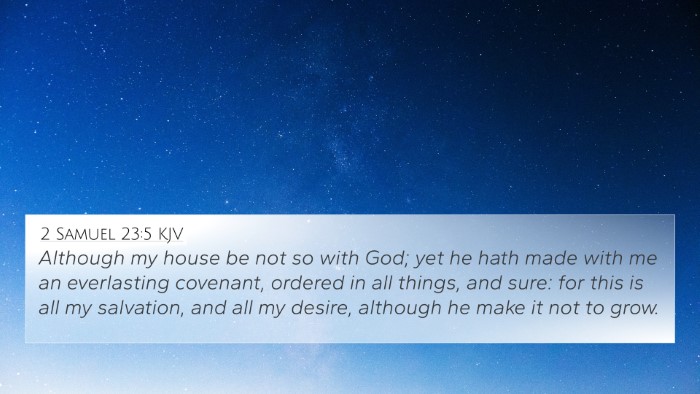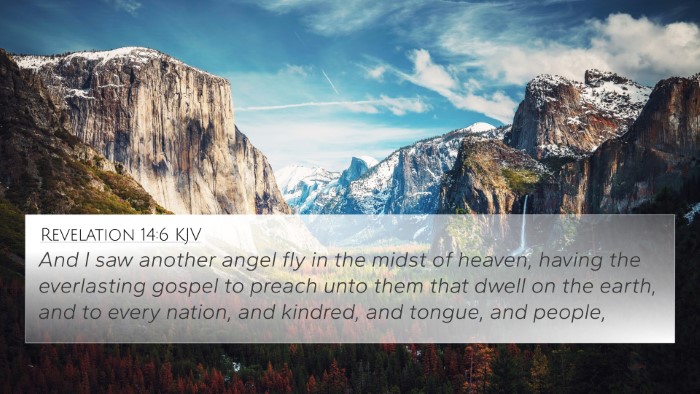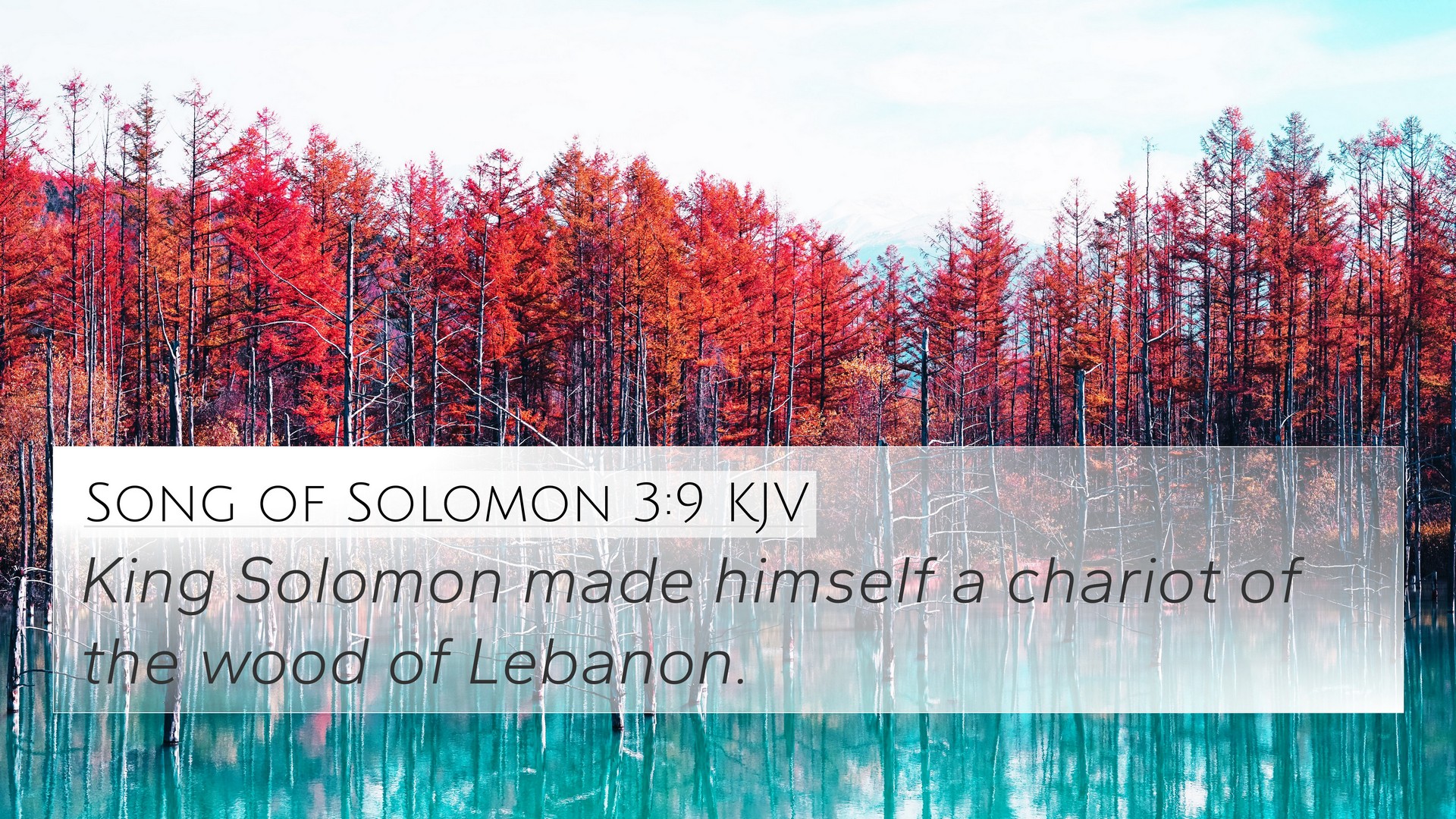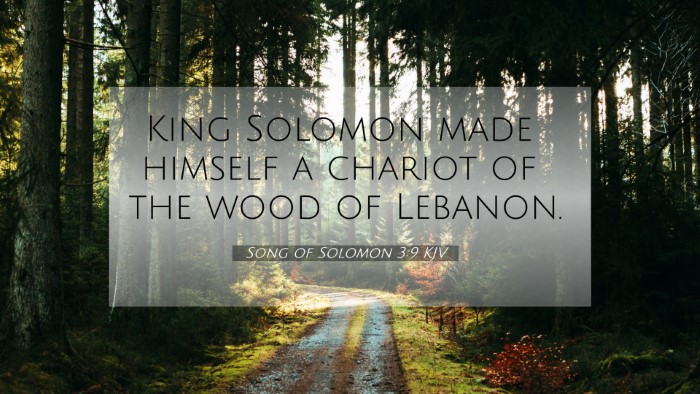Old Testament
Genesis Exodus Leviticus Numbers Deuteronomy Joshua Judges Ruth 1 Samuel 2 Samuel 1 Kings 2 Kings 1 Chronicles 2 Chronicles Ezra Nehemiah Esther Job Psalms Proverbs Ecclesiastes Song of Solomon Isaiah Jeremiah Lamentations Ezekiel Daniel Hosea Joel Amos Obadiah Jonah Micah Nahum Habakkuk Zephaniah Haggai Zechariah MalachiSong of Solomon 3:9 Similar Verses
Song of Solomon 3:9 Cross References
King Solomon made himself a chariot of the wood of Lebanon.
Uncover the Rich Themes and Topics of This Bible Verse
Listed below are the Bible themes associated with Song of Solomon 3:9. We invite you to explore each theme to gain deeper insights into the Scriptures.
Song of Solomon 3:9 Cross Reference Verses
This section features a detailed cross-reference designed to enrich your understanding of the Scriptures. Below, you will find carefully selected verses that echo the themes and teachings related to Song of Solomon 3:9 KJV. Click on any image to explore detailed analyses of related Bible verses and uncover deeper theological insights.

Song of Solomon 3:7 (KJV) »
Behold his bed, which is Solomon's; threescore valiant men are about it, of the valiant of Israel.

2 Samuel 23:5 (KJV) »
Although my house be not so with God; yet he hath made with me an everlasting covenant, ordered in all things, and sure: for this is all my salvation, and all my desire, although he make it not to grow.

Revelation 14:6 (KJV) »
And I saw another angel fly in the midst of heaven, having the everlasting gospel to preach unto them that dwell on the earth, and to every nation, and kindred, and tongue, and people,
Song of Solomon 3:9 Verse Analysis and Similar Verses
Song of Solomon 3:9 reads: "King Solomon made himself a chariot of the wood of Lebanon." This verse serves as a vivid portrayal of the grandeur associated with King Solomon, reflecting not just his royal status but also the dedication to beauty and craftsmanship.
Meaning and Interpretation of Song of Solomon 3:9
The phrase “made himself a chariot” signifies the preparation and effort involved in creating something that reflects one’s character and aspiration. Solomon’s choice of materials from Lebanon, known for its cedars (which symbolize strength and durability), echoes themes of luxury and divine favor.
Insights from various public domain commentaries elucidate different aspects of this verse:
- Matthew Henry: Emphasizes the significance of the chariot as a metaphor for the beloved’s beauty and dignity. He notes that Solomon’s chariot represents not only his royal power but also the love and affection he holds for his bride.
- Albert Barnes: Focuses on the element of preparation and the care taken in constructing such an ornate chariot. He points out that the use of Lebanon wood is significant, as it was known for its quality and beauty, suggesting a divine aspect to Solomon’s endeavors in love and courtship.
- Adam Clarke: Explores the cultural implications of Solomon’s actions. The chariot is not merely a vehicle but a symbol of royalty and status. Clarke also notes that the elaborate nature of the chariot points to the depth of Solomon’s affection and the extravagance that often accompanies true love.
Cross-References to Enhance Understanding
To fully appreciate the richness of Song of Solomon 3:9, it's beneficial to explore several Bible verse cross-references that share thematic elements. Below are some relevant verses:
- 1 Kings 10:22: Discusses Solomon’s wealth and the ships that brought gold, paralleling the luxury implied in the chariot.
- Psalm 45:3-4: Poetically describes a royal figure adorned and “riding on a chariot,” linked thematically to Solomon’s grandeur.
- Isaiah 60:13: Mentions the glory of Lebanon in the context of beauty and grandeur, reinforcing the significance of Solomon’s choice of materials.
- Songs 1:16: Expresses admiration for the beauty of a beloved, akin to the splendor associated with King Solomon’s entourage.
- Ecclesiastes 2:4-6: Solomon speaks about his great works—an exploration of creativity and legacy comparable to crafting a chariot.
- Revelation 21:18: Describes the heavenly city made of precious materials, paralleling the idea of beauty in the creation of Solomon’s chariot.
- Romans 12:1: Speaks to the idea of offering ourselves as living sacrifices—intrinsic beauty made manifest, akin to Solomon's representation of love and devotion.
Understanding the Thematic Connections
This verse invites a comparative Bible verse analysis with its emphasis on love, beauty, and royalty. By examining the connections between Bible verses that relate to each other, deeper meaning can be extracted. Here are some suggestions on how to explore these connections:
- Utilize tools for Bible cross-referencing: Engaging with a Bible concordance or Bible cross-reference guide can facilitate the exploration of linked themes.
- Analyze parallels: Engage in cross-referencing Bible study methods to identify themes of love and devotion in both Old and New Testaments.
- Examine inter-Biblical dialogue: Looking at how different books comment on or reflect upon the themes presented in Solomon’s works can yield rich insights.
Conclusion
The exploration of Song of Solomon 3:9 provides a glimpse into the opulent world of King Solomon and the profound aspects of his relationships, particularly in light of love and devotion. Through careful study and cross-referencing with related scriptures, one can uncover the multi-faceted layers of meaning within this text. By examining Biblical themes and their connections, readers can deepen their understanding of the scriptural narrative surrounding love, beauty, and commitment.


